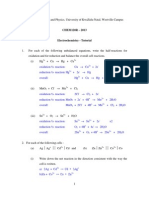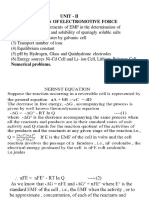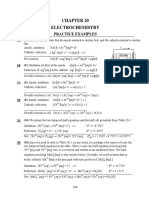Lecture 15: The Nernst Equation: - 49, 50, 52 (Show You Can Do This), 53 (How Much Does Entropy Contribute), 55, 57d
Lecture 15: The Nernst Equation: - 49, 50, 52 (Show You Can Do This), 53 (How Much Does Entropy Contribute), 55, 57d
Uploaded by
Tommy ChenCopyright:
Available Formats
Lecture 15: The Nernst Equation: - 49, 50, 52 (Show You Can Do This), 53 (How Much Does Entropy Contribute), 55, 57d
Lecture 15: The Nernst Equation: - 49, 50, 52 (Show You Can Do This), 53 (How Much Does Entropy Contribute), 55, 57d
Uploaded by
Tommy ChenOriginal Description:
Original Title
Copyright
Available Formats
Share this document
Did you find this document useful?
Is this content inappropriate?
Copyright:
Available Formats
Lecture 15: The Nernst Equation: - 49, 50, 52 (Show You Can Do This), 53 (How Much Does Entropy Contribute), 55, 57d
Lecture 15: The Nernst Equation: - 49, 50, 52 (Show You Can Do This), 53 (How Much Does Entropy Contribute), 55, 57d
Uploaded by
Tommy ChenCopyright:
Available Formats
1
Lecture 15: The Nernst Equation
Reading: Zumdahl 11.4
Outline:
Why would concentration matter in
electrochemistry?
The Nernst equation (contains Concentration
effects on Battery Voltage)
Applications
An entropically-driven battery
Problems (Ch 11 Zumdahl 5
th
Ed.)
49, 50, 52 (Show you can do this), 53 (how much does
entropy contribute), 55, 57d.
2
Concentration and E
cell
Consider the following redoxreaction:
Zn(s) + 2H
+
(aq) Zn
2+
(aq) + H
2
(g)
(spontaneous)
What if [H
+
] = 2 M?
Expect driving force for product formation to increase.
LeChatelier Prinicple
Therefore G
rxn
decreases, and E
cell
increases
How does E
cell
depend on concentration?
0
cell rxn
nFE G = >
0.76
o
cell
V = + E
3
E
cell
depends on Concentration
Recall, in general:
Putting this with our recent result:
The Nernst Equation
0
0
0
10
0
10
ln
ln
0.059
log
5.7log
rxn
rxn
cell rxn
cell cell
cell cell
rxn
nF G G RT Q
RT
Q
nF
Q V
n
G G Q kJ
= =
=
=
= +
E
E E
E E
0
ln
rxn
rxn
G G RT Q = +
4
E
cell
: The Nernst Equation
With the Nernst Eq., we can determine the effect
of concentration on cell potentials.
Example. Calculate the cell potential for the
following:
When [Cu
2+
] = 0.3 M and [Fe
2+
] = 0.1 M
Do you expect the potential to be greater/less than the
Standard potential?
0
10
60
log
cell cell
Q mV
n
= E E
2 2
( ) ( ) ( ) ( ) Fe s Cu aq Fe aq Cu s
+ +
+ +
When [Cu
2+
] = 1 M and [Fe
2+
] = 1 M
5
E
cell
example
First, need to identify the 1/2 cells (table, 11.1).
Get the voltage under standard conditions
2 2
( ) ( ) ( ) ( ) Fe s Cu aq Fe aq Cu s
+ +
+ +
Turn the iron half cell around and add. Note n=2
2 0
2 0
2 0
2 2
( ) 2 ( ) 0.34
( ) 2 ( ) 0.44
( ) ( ) 2 0.44
_______________________________________________
( ) ( ) ( ) ( )
cell
cell
cell
Cu aq e Cu s E V
Fe aq e Fe s V
Fe s Fe aq e V
Fe s Cu aq Fe aq Cu s
+
+
+
+ +
+ = +
+ =
+ = +
+ +
E
E
E
0
0.78
cell
V = + E
6
E
cell
example
Now, calculate Q and then E
cell
.
Notice, the concentrations are in separate containers.
0 0
0 0
2 2
2 2
10
10
(0.1)
0.33
(0.3)
2
0.06
log
0.06
0.78 log 0.33 0.78 0.014 0.80
2
Cu Cu
Fe Fe
An Cat
o
Cell Cell
Cell
Fe Fe
a a
Q
a a
Cu Cu
n
QV
n
V
+ +
+ +
= = = =
=
=
= = + =
E E
E
2 2 0
( ) ( ) ( ) ( ) 0.78
cell
Fe s Cu aq Fe aq Cu s V
+ +
+ + = + E
7
E
cell
another example
If [Cu
2+
] = 0.3 M, what [Fe
2+
] is needed so that
E
cell
= 0.76 V?
2 2 0
( ) ( ) ( ) ( ) 0.78
cell
Fe s Cu aq Fe aq Cu s E V
+ +
+ + = +
0
10
10
10
2 2
2
2
0.059
log
0.059
0.76 0.78 log
2
2 0.02 2
log
0.059 3
4.7
0.3
4.7 0.3 1.4
cell cell
E E Q
n
Q
Q
Fe Fe
Q
Cu
Fe M
+ +
+
+
=
=
= =
= = =
= =
8
Concentration Cells
Consider the cell
presented on the left.
The 1/2 cell reactions
are the same, it is just
the concentrations that
differ.
Will there be electron
flow? Why?
9
Concentration Cells: Concentration Effects Only
Ag
+
+ e
-
Ag E
1/2
= 0.80 V
E
1/2
is measured when all
species are in standard state, so
this means both sides have 1 M
concentrations of Ag
+
.
Therefore , E
cell
= 0.
10
Silver Concentration Cell
Anode: Ag Ag
+
+ e
-
E
1/2
= -0.80 V
Ag
+
+ e
-
Ag E
0
1/2
=+ 0.80 V Cathode:
Driving force for the reaction: Get the concentration up on the
left, so produce more ions there. Will stop when concentrations
in both beakers are equal (Q=1 but not Std State)
0
10
10
(0.1)
0.1
(1.0)
1
0.059
log
0.059
0.0 log 0.1 0. 0.059 0.06
1
Anode
Cathode
cell Cell
cell
Ag
Q
Ag
n
E E Q
n
E V
+
+
= = =
=
=
= = + =
11
Concentration Cells (2
nd
example)
Another Example:
The number of electrons per rxnis different
What is E
cell
?
12
Iron Concentration Cells
Fe
2+
+ 2e
-
Fe
2 e
-
transferredn = 2
E
cell
= 30mV Same Result for Cu/Cu
2+
battery
anode cathode
e
-
2
2
0
10
10
(0.01)
0.1
(0.1)
2
0.059
log
0.059
0.0 log 0.1 0. 0.03 0.03
2
Anode
Cathode
cell Cell
cell
Fe
Q
Fe
n
E E Q
n
E V
+
+
= = =
=
=
= = + =
13
Measurement of pH
pH meters use electrochemical reactions.
Ion selective probes: respond to the presence of a
specific ion. pH probes are sensitive to H
+
.
Specific reactions:
Hg
2
Cl
2
(s) + 2e
-
2Hg(l) + 2Cl
-
(aq) E
1/2
= 0.27 V
Hg
2
Cl
2
(s) + H
2
(g) 2Hg(l) + 2H
+
(aq) + 2Cl
-
(aq)
H
2
(g) 2H
+
(aq) + 2e
-
E
1/2
= 0.0 V
E
cell
= 0.27 V
14
Measurement of pH
Hg
2
Cl
2
(s) + H
2
(g) 2Hg(l) + 2H
+
(aq) + 2Cl
-
(aq)
What if we let [H
+
] vary?
{ }
2
2 2
2 2
0
10
2 2
0
10
0
10 10
2
0.059
log
0.059
log
2
0.059log 0.059log
H
Cell Cell
Cell Cell
Cell Cell
H Cl
Q H Cl
P
n
E E Q
n
E E H Cl
E E H Cl
+
+
+
+
= =
=
=
=
=
Saturate the Chloride ion so that it is constant.
15
Application of pH Measurement
E
cell
is directly proportional to pH or log [H
+
]
electrode
{ }
0
10
(0.0591)log [ ]
59.1
cell cell offset
cell ref
E E E H
E E pH mV
+
= +
= +
16
Summary
None of these ideas is separate. They are all connected,
and are all derived directly from thermodynamics.
0
0
ln
2.48ln
rxn
rxn
electricl
rev rxn
rxn
rxn
w G G X
G G RT Q
G G Q kJ
= =
= +
= +
rxn Cell
G nF = E
0
0.0591
log
Cell Cell
Q V
n
= E E
17
Nernst Equation and half reactions (Z11.52)
Show that the Nernst Equation can be applied to half
reactions as well:
0
1 2 1
1 2
1 0 2 0
1 1 2 2
0.06
log
0.06 0.06
log log
Cell Cell
Cell
Q V
n
Q QQ
Q Q
n n
=
= =
= =
E E
E E E
E E E E
However each half reaction has to be multiplied by some factor so that the
number of electrons is the same for both half reactions.
( ) ( )
1 1
1 1 2 2
1 0 0 0
1 1 1 1 1 1 1
1 1 1 1
0.06 0.06 0.06
log log log
m m
n n m n m
m Q Q Q
n m n m n
= =
= = =
E E E E
So this shows that yes one can do each half reaction separately and get the same
result as doing both half reactions together as a single reaction.
18
Nernst Equation half reactions (Z11.52a)
Apply the Nernst Equation to the Half reaction Cu/Cu2+
So you need to write and balance the half reaction in the
same direction as the half cell EMF is specified, which is
written as a reduction potential in table 11.1
( ) ( )
( )
( )
2
2
2
1 0
1 1
1
0.34 2
1
2 0.1 10
0.06 0.06
log 0.34 log10 0.34 .07 0.27
2
o
V Cu aq e Cu s
n Cu aq M Q
Cu aq
Q V
n
+
+
+
= +
= = = =
= = = =
E
E E
19
Sample Problems (Z11.49, 52)
Analyze the galvanic cell for the reaction:
3
3 1.5
0.34
o
o
Au e Au V
Tl e Tl V
+
+
+ =
+ =
E
E
As you can see it really doesnt matter what the metals are: The overall
cell is just the sum of the half cell potentials
For later we need to know that n=3 and have the balance reaction for the
cell:
3
3 3 1.84
o
cell
Au Tl Au Tl V
+ +
+ + = E
Get Gibbs energy and K:
So a 2V battery is VERY
Spontaneous.
ln
550
1.84
ln 3 220
0.025 0.025
o o
rxn Cell
o
rxn
o
Cell
G nF RT K
G kJ
K n
= =
=
= = =
E
E
20
Sample (Z11.49, 52)
How much change in EMF if product and reactant
concentrations are low? There is a trade off.
3
3 2 4
3 3 1.84
110 110
o
cell
Au Tl Au Tl V
Au Tl M
+ +
+ +
+ + =
= =
E
3
12
0 10
2
3
0
0.0591 10
log 10
10
0.6
log10 0.46 1.8 0.46 2.3
3
Cell Cell
Cell Cell Cell
Tl
Q Q
n
Au
V
+
+
= = = =
= = = + =
E E
E E E
The voltage will stay up until the Gold ion concentration goes way down.
Thats the way batteries are: When they start to go out, they go quickly.
21
Lead Acid Car Battery (Z11.53)
For the car battery, calculate the standard EMF at -20C.
( ) ( ) ( )
( ) ( ) ( )
( ) ( )
2
2 2
2 2 8
4 4
2
2
4 2 2
1.3 10
Shorthand/no salt bridge
sp
Pb s PbO s H Pb aq H O
Pb aq SO aq PbSO aq K
Pb s Pb PbO s
+ +
+
+
+ + +
+ =
The EMF is the total for both reactions; does the
second reaction increase the EMF or decrease it?
2.04
o
cell
V = E
o o o o
Rxn Cell Rxn Rxn
G nF H T S = = E
An extra question: What percentage of the battery is driven
entropicallyunder standard conditions?
0.298 263 78
0.2 20%
316 0.298 263 395
o
Rxn
o
Rxn
T S
G
= = = =
+
The reaction is exothermic and the entropy is positive. So bothparts contribute
to the battery functioning. Because the entropy is positive theEMF of the cell
will be smaller at lower temperatures. It is not surprising that a battery works
worse at low temperatures.
22
The Concentration Battery (Z11.55)
Two cells, each contains Ni metal and Ni
2+
ions.
Why would there be any potential at all?
The concentration in the different Beakers is different.
Eg(c) 1 M Ni
2+
in beaker A and 0.1M Ni
2+
in beaker B.
What is the standard EMF ?
What is the EMF?
Which way do the electrons go?
What is the concentration of Ni
2+
in A/B at equilibrium?
What is EMF at equilibrium?
( ) ( ) ( ) ( )
2 2
A A B B
Ni s Ni aq Ni aq Ni s
+ +
0
10
2
0
2
0.0591
log .03log 10 0.03 30
0 10 2
Cell Cell
A
Cell
B
Q V mV
n
Ni
Q n
Ni
+
+
= = = =
= = = =
E E
E
Not spontaneous in
direction written.
It is a totally Entropic
battery!!!!!
You might also like
- Maths in Focus Ext 1 SOLUTIONSDocument124 pagesMaths in Focus Ext 1 SOLUTIONSVanessaChen50% (4)
- Nernst EqnDocument17 pagesNernst EqnDella Fajar PNo ratings yet
- CHE1000 & 1010 - Tutorial Sheet 5 Marking KeyDocument10 pagesCHE1000 & 1010 - Tutorial Sheet 5 Marking Keychimfwembeemmanuel712No ratings yet
- Solution For Exercise Series 2: E E E G E VFDocument6 pagesSolution For Exercise Series 2: E E E G E VFshah faisalNo ratings yet
- Electro SulDocument4 pagesElectro SulChutvinder LanduliyaNo ratings yet
- Nernst Equation Assignment (Good Copy)Document12 pagesNernst Equation Assignment (Good Copy)SV - 12MP 794627 Erindale SSNo ratings yet
- Electrochemistry: Applications of RedoxDocument29 pagesElectrochemistry: Applications of RedoxrachelelkinNo ratings yet
- Chapter 18 BQDocument10 pagesChapter 18 BQTarek GhaddarNo ratings yet
- Tutorial 3 Electrochemistry - AnswersDocument10 pagesTutorial 3 Electrochemistry - AnswerssgarrabNo ratings yet
- Module 1 - Electrochemistry (Part 2)Document13 pagesModule 1 - Electrochemistry (Part 2)Steven LeeNo ratings yet
- Determination of Electrode PotentialsDocument26 pagesDetermination of Electrode PotentialsGliezl ImperialNo ratings yet
- Electrochemistry Ch20bDocument13 pagesElectrochemistry Ch20bSiti Aisyah RuzelanNo ratings yet
- Spontaneity of Redox ReactionsDocument21 pagesSpontaneity of Redox Reactionssaeikip0% (1)
- Electrochemistry Complete NCERTDocument20 pagesElectrochemistry Complete NCERTNitesh YadavNo ratings yet
- Electro Chemistry Part-1Document2 pagesElectro Chemistry Part-1Santpal KalraNo ratings yet
- Electrochemical Cells at Non-Standard Condi-Tions: The Nernst EquationDocument6 pagesElectrochemical Cells at Non-Standard Condi-Tions: The Nernst Equationrodelyn ubalubao100% (1)
- Nernst Equation Example Problems: Echem - MCD 1/3/02Document9 pagesNernst Equation Example Problems: Echem - MCD 1/3/02sparkshockNo ratings yet
- Tutorial 4 - Fundamentals of ElectrochemistryDocument17 pagesTutorial 4 - Fundamentals of ElectrochemistryAbd El-Fattah Mohamed OufNo ratings yet
- Exam 3 SolutionsDocument9 pagesExam 3 SolutionsMishka King100% (1)
- Cell PotentialDocument39 pagesCell Potentialellamae sanbuenaventuraNo ratings yet
- 22CHE22-notesModule 1Document24 pages22CHE22-notesModule 1Vinay AdariNo ratings yet
- Cell Galvanic PDFDocument10 pagesCell Galvanic PDFWilliam FernandoNo ratings yet
- L2 - Daniell - Jacobi CellDocument6 pagesL2 - Daniell - Jacobi CellIuliana CovaliuNo ratings yet
- Applications of EMF Sem-6Document57 pagesApplications of EMF Sem-6Mahmood YacoobaliNo ratings yet
- Chapter 10 ElectrochemistryDocument76 pagesChapter 10 ElectrochemistryPatrickNo ratings yet
- Chapter 20 - ElectrochemistryDocument5 pagesChapter 20 - ElectrochemistrySai SanigepalliNo ratings yet
- Chapter 2electrochemical Cells EditedDocument50 pagesChapter 2electrochemical Cells EditedAdugnaw BiksNo ratings yet
- Solutions-Electrochemistry Practice ProblemsDocument6 pagesSolutions-Electrochemistry Practice ProblemsNga TranNo ratings yet
- Electrochemistry: Applications of RedoxDocument40 pagesElectrochemistry: Applications of Redoxcatsathish1No ratings yet
- Chem 340 - Notes 12Document9 pagesChem 340 - Notes 12Akef AfanehNo ratings yet
- Experiment C4- ElectrochemistryDocument12 pagesExperiment C4- Electrochemistryshivshekraghav2008No ratings yet
- 12 Board Practice Que Chemistry Electrochemistry Harsh SirDocument56 pages12 Board Practice Que Chemistry Electrochemistry Harsh Sirdev05savaliyaNo ratings yet
- MITHFH Lecnotes26Document7 pagesMITHFH Lecnotes26nenavathg38No ratings yet
- Chapter 17 ElectrochemistryDocument56 pagesChapter 17 ElectrochemistryplatinumauthorsNo ratings yet
- Electrolysis in Aqueous SolutionDocument15 pagesElectrolysis in Aqueous SolutionEdon BediNo ratings yet
- 3 Electrochemistry NCERT Soln.Document20 pages3 Electrochemistry NCERT Soln.hulkahsanNo ratings yet
- Electrochemical Cells: (Review Electrochemistry in CHM 102)Document43 pagesElectrochemical Cells: (Review Electrochemistry in CHM 102)Najmul Puda PappadamNo ratings yet
- 20 Petrucci10e CSMDocument66 pages20 Petrucci10e CSMAlexNo ratings yet
- Laily Jannati - 193010208001 - Elektrokimia Exp 6,7,8,9Document4 pagesLaily Jannati - 193010208001 - Elektrokimia Exp 6,7,8,9Anas Tasya GultomNo ratings yet
- Lab Report Exp 3 Electrochemical CellDocument5 pagesLab Report Exp 3 Electrochemical CellYe Woon LimNo ratings yet
- Question 801367Document4 pagesQuestion 801367niveditasingh2472No ratings yet
- Malate + NAD Oxaloacetate + NADH + HDocument14 pagesMalate + NAD Oxaloacetate + NADH + HRonaldNo ratings yet
- Electro Chemistry TheoryDocument14 pagesElectro Chemistry TheoryPranivoidNo ratings yet
- Electrochemistry JM QuestionsDocument26 pagesElectrochemistry JM Questionsappu78No ratings yet
- Electrochemistry: Practice ExamplesDocument35 pagesElectrochemistry: Practice ExamplesJudith Del Valle Morejon100% (2)
- Scan Nov 15, 2020Document18 pagesScan Nov 15, 2020Shikhar GuptaNo ratings yet
- Nernst EquationDocument7 pagesNernst Equationantony2288No ratings yet
- Chemistry HandoutDocument42 pagesChemistry HandoutpsrikruthinNo ratings yet
- Electrochemistry Imp Questions Paper 2Document2 pagesElectrochemistry Imp Questions Paper 2tikam chandNo ratings yet
- Problem Set 5 Fall 2018 With SolutionsDocument4 pagesProblem Set 5 Fall 2018 With SolutionsrickNo ratings yet
- Electrochemistry 7Document20 pagesElectrochemistry 7kadebiyiojoNo ratings yet
- Chem 114 Lab - ElectrochemistryDocument16 pagesChem 114 Lab - ElectrochemistryKaizNo ratings yet
- 1 - Galvanic CellDocument6 pages1 - Galvanic CellafifiNo ratings yet
- NCERTSolutions Class 12 Chemistry ElectroChemistryDocument19 pagesNCERTSolutions Class 12 Chemistry ElectroChemistrymanandave906No ratings yet
- Student Solutions Manual to Accompany Economic Dynamics in Discrete Time, second editionFrom EverandStudent Solutions Manual to Accompany Economic Dynamics in Discrete Time, second editionRating: 4.5 out of 5 stars4.5/5 (2)
- Feynman Lectures Simplified 2C: Electromagnetism: in Relativity & in Dense MatterFrom EverandFeynman Lectures Simplified 2C: Electromagnetism: in Relativity & in Dense MatterNo ratings yet
- Practice Makes Perfect in Chemistry: Oxidation-ReductionFrom EverandPractice Makes Perfect in Chemistry: Oxidation-ReductionRating: 5 out of 5 stars5/5 (1)
- Zagheni Weber2015Document13 pagesZagheni Weber2015Roman TilahunNo ratings yet
- Jsa Log Source User GuideDocument133 pagesJsa Log Source User GuidethaliaNo ratings yet
- Probability and Random Processes (15B11MA301 (15B11MA301 Probability and Random Processes 15B11MA301) 15B11MA301)Document16 pagesProbability and Random Processes (15B11MA301 (15B11MA301 Probability and Random Processes 15B11MA301) 15B11MA301)Aditya gaurNo ratings yet
- C4 Differential Equations - First OrderDocument40 pagesC4 Differential Equations - First OrderDan FogginNo ratings yet
- ConfidentialDocument8 pagesConfidentialhannahjoymachucateberioNo ratings yet
- Get (Ebook PDF) Applied Mathematics For The Managerial, Life, and Social Sciences 7th Edition PDF Ebook With Full Chapters NowDocument51 pagesGet (Ebook PDF) Applied Mathematics For The Managerial, Life, and Social Sciences 7th Edition PDF Ebook With Full Chapters Nowherwigmurtaz100% (4)
- 05 RaceDocument2 pages05 RaceAditya ThakurNo ratings yet
- Appendix A: Conversion FactorsDocument18 pagesAppendix A: Conversion FactorsJose Fernando Solanilla DuqueNo ratings yet
- MTH 101 Mid Term PapersDocument106 pagesMTH 101 Mid Term PapersTayyab basitNo ratings yet
- Paper-2 - With Answer - MathematicsDocument6 pagesPaper-2 - With Answer - MathematicsAnsh GuptaNo ratings yet
- Practice GraphDocument12 pagesPractice GraphER ABHISHEK MISHRANo ratings yet
- Statistics For MGMTDocument140 pagesStatistics For MGMTanandashankaraNo ratings yet
- V I ExerciseAnswersDocument95 pagesV I ExerciseAnswersRony Pestin0% (1)
- Comparing Frege and Russell On The Concept of A NumberDocument4 pagesComparing Frege and Russell On The Concept of A NumberAlok KumarNo ratings yet
- RecursionDocument66 pagesRecursioncs.ramgopal7036No ratings yet
- Mathematics: Bansal ClassesDocument5 pagesMathematics: Bansal Classessuar90No ratings yet
- Logistic Regression NotesDocument79 pagesLogistic Regression NotesSwanky Devania AudiNo ratings yet
- ExcerptDocument10 pagesExcerptROCCONo ratings yet
- Logarithms FormulasDocument3 pagesLogarithms FormulasVamsi SrimathirumalaNo ratings yet
- MSMB Topic SampleDocument10 pagesMSMB Topic SampleAntima Jayprakash ShardaNo ratings yet
- Arrow CESFunctionDocument27 pagesArrow CESFunctionsmierdakovNo ratings yet
- The Ilieff-Sendov Conjecture Robert "Dr. Bob" Gardner Fall 2011Document11 pagesThe Ilieff-Sendov Conjecture Robert "Dr. Bob" Gardner Fall 2011TOM DAVISNo ratings yet
- College Level Math Practice TestDocument17 pagesCollege Level Math Practice TestHarsha Kasaragod100% (1)
- Comparing Machine Learning Models With Witczak NCHRP 1-40D Model For Hot-Mix Asphalt Dynamic Modulus PredictionDocument13 pagesComparing Machine Learning Models With Witczak NCHRP 1-40D Model For Hot-Mix Asphalt Dynamic Modulus Predictionmohammad faresNo ratings yet
- BOW in GEN MATH 11Document2 pagesBOW in GEN MATH 11Eric ManotaNo ratings yet
- PDA PFEQ Mathematique-Secondaire 2016 enDocument44 pagesPDA PFEQ Mathematique-Secondaire 2016 enEdison YuNo ratings yet
- Exponentials and Logarithms: MathematicsDocument16 pagesExponentials and Logarithms: MathematicsMahima AgrawalNo ratings yet
- PreCalculus Unit 1 SummativeDocument2 pagesPreCalculus Unit 1 SummativeShams MughalNo ratings yet
- Computers and Electrical Engineering: Uche A. NnolimDocument12 pagesComputers and Electrical Engineering: Uche A. NnolimibmplaceNo ratings yet

























































































